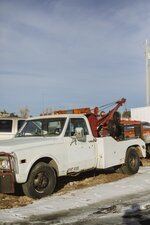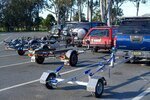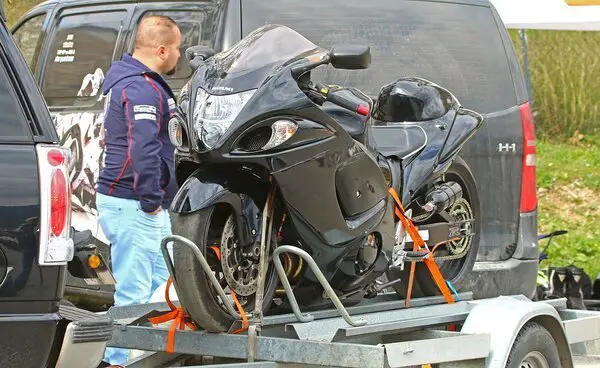How do you tow a motorcycle with a car on your own? While you may think you need to pay a towing company, it’s not that hard.
First things first, you need to understand why there are so many regulations behind towing. If you tow a big heavy vehicle incorrectly, it can threaten the drivers behind you. And improper weight distribution can even affect your safety.
Next, get your equipment together. You’ll need a towing vehicle, your motorcycle, a trailer/dolly/carrier, some straps, and chocks to secure the bike.
Some jurisdictions may also require you to acquire a license or a permit. But in others, you can get by with just sufficient knowledge.
And on that note, you should know how to tow a motorcycle with a car. That last bit is what we’re here for. Here’s how you can tow a bike with a trailer.
How to Tow a Motorcycle with a Trailer – Step By Step:
Step 1: Find A Suitable Trailer

The first step is to find the right trailer. Instead of buying your trailer, consider renting one since most rental companies do the hard work for you.
You can get off pretty easy with just a 5×9-feet trailer if you only have a maximum of two bikes to trail. If you have more, you’ll need a bigger trailer. Some trailers may offer spaces to tie down the bikes to prevent them from falling.
Avoid trailers that have small tires. While bikes are lighter than cars, reducing the tire size only means instability during driving. Invest in a bigger, heavier trailer that won’t sway from side to side.
Step 2: Find A Trailer Ramp

The ramp is the part of the trailer that helps you load and unload your bikes. There are two key factors to consider here: the ground clearance and the wheelbase. The ground clearance is the distance from the lowest point of your motorcycle (usually halfway between the wheels) and the ground. The wheelbase is the distance between the centers of the rear and front wheels of your bike.
Make sure your ramp fits these two measurements. It should be long enough to accommodate the wheelbase and high enough to house the ground clearance.
Step 3: Get a Towing Vehicle
To tow the motorcycle, you’ll need a towing vehicle. The vehicle must be fitted with the appropriate hitch and ready to tow up to two thousand pounds. It’s also mandatory for the vehicle to have rear-wheel drive. If you’re lucky enough, your car or SUV can easily fit this criterion. You can get the correct type of hitch fitted through an aftermarket seller.
Keep in mind, the more weight you need to tow, the bigger or stronger the vehicle you’ll need. In case your present vehicles don’t fit the criteria, you can always rent a small half-ton truck.
Step 4: Gather Your Ratchet Straps and Wheel Chocks
Before you start loading your bike, be sure to buy come ratchet straps and wheel chocks beforehand. Ratchet straps are the most accessible types of straps when it comes to compressing the suspension. Plus, they’re cheap and can be bought from most hardware stores.
Wheel chocks are special materials made of plastic or metal that prevent the bike’s wheels from moving. They may not be required all the time, but you’ll need one if you’re loading the bike alone or on a hill.
Step 5: Load Your Bike

Now it’s time to start loading the bike. Gently place the ramp between the ground and the bed of the trailer and start loading the bike front wheel-first. Place your wheel chock ahead of time in the trailer’s bed and gently slide the front wheel of your bike into it.
Step 6: Secure Your Bike
To secure the bike, you’ll first need to pull down the kickstand to keep the bike from falling. Then strap the bike to the trailer’s rail or any part on the trailer. A general rule of thumb is to strap the trailer low and the bike high to maximize stability.
Attach the front left strap to the trailer on one end and anywhere on the frame on the other end. Repeat the same with the front right strap.
If you don’t want to attach the ratchet straps directly to the bike, you can make a loose loop using a soft strap and attach the strap to it.
Once you’ve secured the straps, ratchet them down by pulling the slack out. You will notice that your bike is now in an upright position, and your front suspension is compressing down.
One thing to keep in mind is never to secure the ratchets to the bike’s handlebars. They’re not designed to withstand such pressure.
Now repeat the same process for the rear of the bike. Again, be careful not to secure the straps to guards, trunks, saddlebags, or other fragile components.
Step 7: Do a Few Test Drives
Before you take your tow vehicle out, it’s a good idea to do some test drives. You don’t want your expensive bikes to come loose when you’re driving on the highway.
While you’re at it, recheck the straps and maybe cover the bike with a tarp or any other suitable waterproof cloth. The primary purpose of this is to overcome any unexpected changes in the weather.
3 Methods to Tow a Motorcycle:
You can’t learn how to tow a motorcycle with a car without knowing these three popular towing methods:
With A Towing Trailer:
Perhaps, one of the easiest ways to tow your motorcycle is with a towing trailer. These trailers can be rented for cheap and often maintained to specific government standards. Trailers are the most capacious out of any towing material.
Towing trailers are a lot securer since the bike is kept well above-ground and strapped to the rails of the trailer. What’s more, some trailers come with backlights and indicators too.
With A Tow Dolly:
The main problem with towing trailers is their large size. If you don’t have anywhere to store a tow trailer, you can use a tow dolly.
While not very popular, especially for motorcycles, tow dollies can be just as secure as trailers. They’re a lot smaller, though, so they’re not suitable for towing larger bikes or more than one bike.
In a tow dolly, the bike’s front wheel is attached to the dolly and raised slightly above the ground. The rear wheel, however, is left rolling on the road behind.
With A Motorcycle Carrier:
If a tow dolly looks too risky, there’s a third option for you: the motorcycle carrier. Unlike in a tow dolly, where the bike trails behind you, in a motorcycle carrier, the bike sits at the back of your car. It stays secured to your trunk and straddles along with your vehicle as it moves.
How to Tie Down a Motorcycle on a Trailer without a Chock:

It is possible to tie down a bike without a chock, but there’ll be a lot of tension on the ratchet straps. To reduce the stress, you can:
- Tie down soft straps on the bike and attach them to the ratchet straps.
- Aside from the regular anchoring points at the front and the rear, you can also strap down the bike from the side.
- Keep the straps as tight as possible.
- Keep your shocks compressed so that the straps don’t come loose when your vehicle hits a bump.
- Finally, be sure to test the system out before your final journey.
However, if you can use a wheel chock, use it. The difference may be subtle, but the result will be worth it. Without a chock, you’re compromising on the security of your bike and the ratchet straps.
How Do You Tie Down A Motorcycle with Ratchet Straps?
So, that’s how to tow a motorcycle with a car. As you can see, you’ll need to use a lot of ratchet straps. But how do you use one to tie down your bike?
First, identify the best anchoring points. The ideal anchoring points are two at the rear, two at the front, and at least one side.
Start with the front straps. Take your windlass and pass the slack through the slot. Tie one end of the slack to your anchoring point and pull the other through the slot. Then pull up and down on your windlass to tighten the slack as much as you can. The other end of your windlass will have a strap that will be tied down to your trailer.
Repeat the same for the second front strap. For this, you might want to untighten the first strap so you can pull your bike upright first. Then retighten the first strap and tie-down your second ratchet strap. Repeat the same for the rear and side anchoring points.
Is It Legal to Tow A Motorcycle with A Car?
Now you know how to tow a motorcycle with a car. But is it legal to do so? Laws vary by location. So, there’s no correct answer to this question. But many laws allow towing motorcycles with a trailer behind a car, provided the vehicle can handle the weight.
The real problem comes when the motorcycle is towed without a trailer while the driver is on it. Again, this varies by location. But in some jurisdictions, motorcyclists can only tow behind other motorcyclists.
Towing behind a car (without a trailer while you’re still on the bike) is majorly illegal. But you should still check up on local laws.
Conclusion
Towing your bike with a trailer may seem tricky, but it’s not rocket science. Once you learn how to tow a motorcycle with a car, the task becomes a whole lot easier.
To tow a bike, you’ll first need to rent a tow trailer and ramp. You’ll also need to ensure you have a vehicle that can handle the towing. You may need to rent a small truck to do the job. To secure the bike, ratchet straps are the best as they’re the strongest and easiest to use.
Now that you know how to tow your motorcycle, there’s no time to waste. Get your bike ready and rent your trailer today!


